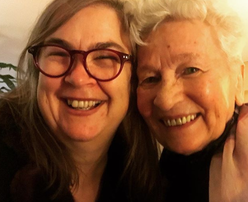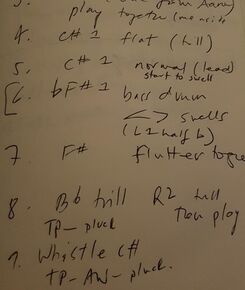What is it about French composers Éliane Radigue and Lionel Marchetti?






At the end of this month, there will be two performances that showcase the work I have done with French composers Éliane Radigue and Lionel Marchetti since 2012 to date.
There is something about this music that keeps me re-engaging with the composers. This is a music that is beyond notation, and closely linked to process, intellect and the nature of the instrument: be that a speaker or a flute. It is a music that pushes back against expectations, but in a delicate, warm and thread like way.
For the listener, the description of 'ambient' downplays the detail in this work. The whispering air, the edge of bow hair, the surprising fullness of wolf tones and multiphonics. What seems to be simplicity contains incredible complexity upon closer examination, easy to miss for the less virtuosic listeners within what Julien Bécourt calls Radigue's 'art of slowing down.' This is a music that reveals itself, where understanding the beginning requires and experience of the end, in what Micheal Terren in Medium Magazine calls 'a sound field of profound and mesmerising complexity'.
The connection between Radigue's transition from synthesiser to acoustic instruments, and Marchetti's ongoing quest to make the speaker invisible, is an important link between these two composers, and why Marchetti continues to be the foremost diffusor of Radigue's work. What is 'a sound' in a work of music? Neither of these composer relies on the concept of a 'note' to define that for them. When do we need to perform these sounds, and when should we just playback? Where is the space between these two states? These somewhat banal questions contain unlimited rich investigations that can only be resolved in the nature of sound in performances themselves. I attempt to discuss this in an article with Stephanie Erslake around the time my alto flute solo, OCCAM XVI was premiered last year. Radigue's acoustic music would be impossible without her work on the ARP synthesiser. Likewise, Marchetti's diffusion practice informs everything about his works for Decibel new music ensemble, that involve an invisible dialog between sounds form the speaker and those created by the performers, in an attempt to erase the electronic technology.
It is strange there is so little writing about both these artists recent work. A couple of academic papers in english including one by myself, alongside a short book in French about Radigue's around the time Naldjorlak I II III was released examine some of the process around this work. But for Marchetti, there is little aside from reviews and copious releases on his Bandcamp page. This year celebrates 25 years of practice, celebrated with a 6 CD Box Set. You can read a bit more about the partition concrete concept in an interview on SeeSaw magazine.
So for now, the best way to understand what is unique about these composers and the performances of their work is to go and experience them. Decibel and Lawrence English provide an Australian link to these composers. This is a music that is difficult to experience fully as a recording. This is, as Darren Jorgenson has claimed, the new classical canon. It will take time for everyone to catch up.
Decibel perform work by Lionel Marchetti with the composer in an extensive concert presentation in Perth on the 26th of August. Tickets Here. You can also catch Lionel Marchetti with Decibel as part of Extended Play. Tickets Here. Decibel with Lionel Marchetti and Lawrence English present music by Eliane Radigue in Melbourne on the 30th of August. Tickets Here.
Want to know more?
Listen to the album of collaborations between Decibel, Lionel Marchetti and Cat Hope here. See a music video for the Marchetti/Hope collaboration here. See a performance of the first commissioned Marchetti work by Decibel here, and a taster of Occam Hexa II, the Radigue/Robinson Piece commissioned by Decibel here. See past concert programs of these works here.
